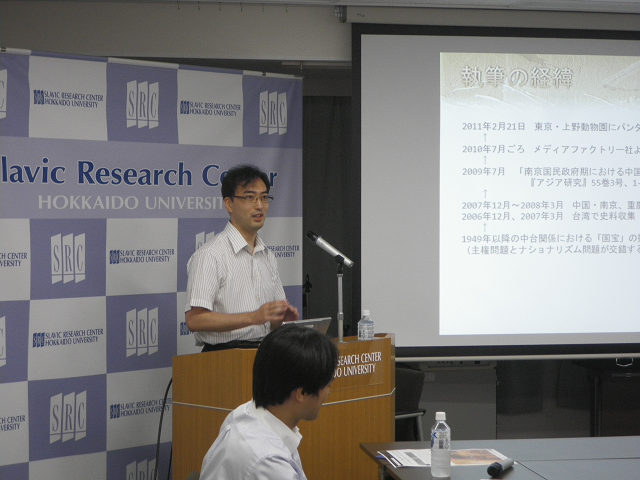
The GCOE-SRC Special Seminar "China's Panda Diplomacy in terms of Borders Studies" (15 July 2011) Report
2011/07/18
The GCOE-SRC Special Seminar -
"China's Panda Diplomacy in terms of Borders Studies"
The GCOE-SRC Special Seminar "China's Panda Diplomacy in terms of Borders Studies" was held at the Slavic Research Center, Hokkaido University, on Friday, July 15, 2011. The speaker was Masaki Ienaga (PhD candidate of The Graduate School of Arts and Sciences, University of Tokyo).
Mr. Ienaga is becoming recognized as a promising and lively Chinese historian. His research interests include national construction and nationalism in contemporary China. He focuses particularly on national cultural assets, such as the panda or the collections in the national palace museum. Earlier this year, he published Panda Diplomacy (in Japanese) through Media Factory.
Mr. Ienaga°«s presentation on this occasion was a history of China's Panda Diplomacy; for example, the °»discovery°… of panda during the second half of nineteenth century, a gift of one to the USA in 1941, and the continued diplomatic resonance of the panda through the Cold War, the normalization of Sino-Japanese diplomatic relations, and into the present. He emphasized that China adopted what was originally a Western view of the panda and that as a consequence, the panda became one of China's °∆national treasures°«.
Report by Masashi HOSHINO,
Slavic Research Center, Hokkaido University


"China's Panda Diplomacy in terms of Borders Studies"
The GCOE-SRC Special Seminar "China's Panda Diplomacy in terms of Borders Studies" was held at the Slavic Research Center, Hokkaido University, on Friday, July 15, 2011. The speaker was Masaki Ienaga (PhD candidate of The Graduate School of Arts and Sciences, University of Tokyo).
Mr. Ienaga is becoming recognized as a promising and lively Chinese historian. His research interests include national construction and nationalism in contemporary China. He focuses particularly on national cultural assets, such as the panda or the collections in the national palace museum. Earlier this year, he published Panda Diplomacy (in Japanese) through Media Factory.
Mr. Ienaga°«s presentation on this occasion was a history of China's Panda Diplomacy; for example, the °»discovery°… of panda during the second half of nineteenth century, a gift of one to the USA in 1941, and the continued diplomatic resonance of the panda through the Cold War, the normalization of Sino-Japanese diplomatic relations, and into the present. He emphasized that China adopted what was originally a Western view of the panda and that as a consequence, the panda became one of China's °∆national treasures°«.
Report by Masashi HOSHINO,
Slavic Research Center, Hokkaido University








